







Diving German WW1 minelaying submarine UC-42.
Sidescan sonar image of Wreck of 1692 (to be confirmed) discovered by Carroll O'Donoghue, owner/operator of HARPY, in 2015.
A selection of our underwater survey hardware. We're ready when you need us.
Wreck-diving off the Old Head of Kinsale
Commercial Divers working on undersea pipes outside Kinsale harbour.
Recovering Diver after ascent from Lusitania wreck.
Sunset in Kinsale, pictured from the quays.
A two hour documentary, to be broadcast by National Geographic in the US, began filming off the coast of Kinsale 02-Aug-2011 and finished on 10-August. Kinsale Angling boat HARPY acted as support vessel to the GRANUAILE and also for filming some of the sequences.
The weather on the day of these photos was not unlike that of the fateful day of 7th May, 1915 - bright and calm. Some of the photos will show the coast in the diatance. Though the coast may look near, for almost 1200 souls it was a lifetime away.
Also, an additional foray was made on 22-Aug-2011 to recover some artefacts from the Lusitania and some photos of this are also included.
Produced by Lusitania Productions Ltd, in association with M3TV, the documentary, entitled The Dark Secret of the Lusitania, will attempt to uncover the mystery surrounding the sinking off the South West coast of Ireland in May 1915.
The documentary was co-produced by Aidan Mulcahy (From Here to Maternity) of Cork-based production company M3 with Dave Harding (Cave of Forgotten Dreams) executive producing. Niall Mahoney of Musketeer Production Services in Cork provided production support for the project.
The wreck of the Lusitania is owned by 83 year old American businessman Gregg Bemis, travelled to Ireland to take part in the expedition. The Lusitania was torpedoed on May 7th 1915 by a U-boat off the coast of Cork. It took just 20 minutes to sink and approximately 1,200 people were killed. Rumours of a second explosion on the ship have led to speculation that there may have been ammunition on board the passenger vessel.
The project used the local production services of Musketeer Production Services. Niall Mahoney of Musketeer explained that the production requires a lot of specialist equipment including atmospheric diving suits (Newtsuit), which allow the diving team more time to examine the wreck. Musketeer were instrumental in the prepping, and arranging the ‘crewing, shipping, docking, loading, dealing with Ringaskiddy Docks, the Irish Lights vessel Granuaile, ensuring power requirements were met, all the technical bits and pieces,’ ahead of filming.
The production was based in the Granuaile Vessel which was chartered for the eight day trip and remainded above the wreck of the Lusitania for the dive. There were five different cameras filming the wreck, explained Niall: ‘We will have HD cameras on the submarine, on the Newtsuit and the diving team will take down a camera. The ROV (Remotely Operated Vehicle) will have a camera as well. And then we will have pole camera which will dip inside the ship once it opens up.’ A production office was set up in Kinsale, which was the closest land location to the wreck. The Dark Secret of the Lusitania was filmed in HD digital.
The technical diving team was led by Irish diver Eoin McGarry with most of the sea faring crew and almost all of the television crew and support coming from Ireland. Niall Mahoney of Musketeer Production Services said the crew has been ‘handpicked to be multi-skilled. They need to be fit, they need to look after each other, and they need to undergo special safety at sea training. The crew are multi-talented and multi-skilled.’
Niall says that the use of Cork crew and support on the massive production shows the capabilities of the Cork production industry, ‘we can offer specialisation; multi-skilled, multi-talented people with lots of ideas and abilities with new technologies who can fit into any number of productions,’ he says.
The Dark Secrets of The Lusitania will be broadcast on National Geographic in 2012. Photographs here copyright C.Ó Donnchú unless stated otherwise.
This is the evening group photo of those who freely took part on the dive of 22-Aug to recover items from the Lusitania of which some will hopefully go to Irish museums with the blessing of Gregg Bemis.
On Deck, (L to R): Eoin McGarry (chief diver),Lar Dunne (archaeologist), Frank McKenna, Wochek Bacun, Philip Murphy, John Corbett, Julianne O'Donoghue (archaeologist), Carroll O'Donoghue (HARPY skipper).
On wheelhouse roof, (L to R): Alan Sheridan, Pat Holligan
Petr Stach took the photo and we are all waiting for the last two divers to surface after decompression stops lasting over 4 hours.

Chief technical diver Eoin McGarry takes the divers through the days diving plan and safety procedures.
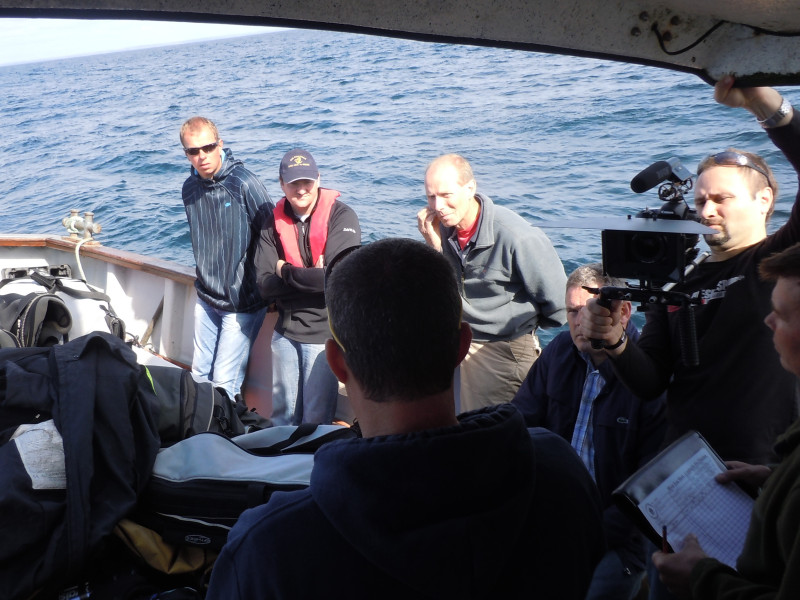
Archaeologists Lar Dunne and Julieanne O'Donoghue take the first brass porthole recovered from the divers and prepare it for safe storage and shipment.
Lar Dunne points the main hairline crack to Julieanne O'Donoghue.
Archaeologist Julieanne O'Donoghue catalogues porthole #1 lifted from Lusitania.
Square porthole recovered.
A lighter moment as square porthole #2 is brought aboard
Preliminary inspection of porthole #3 showed some signs of blast damage.
Porthole #4 after being brought aboard HARPY. The warping of the frame of this port can clearly be seen and are testament to the streses placed on the ship during the sinking.
Porthole #4 on HARPY's deck. Note glass is missing and the frame is warped.
The Irish Naval Service kept a watch on proceedings throughout the day. Here offshore patrol vessel L.E. "Niamh" (P52) passes close by as final prepatations are made to raise the Lusitania's telegraph.
In the foreground is the "Rón Carraig" crewed by Gavin Tivy and Pat Waide whose aft derrick was used to lift the telemotor.
The heavier lifting equipment of the Rón Carraig were required to lift the heavy phosphor-bronze telegraph for one of the Lusitania's engines. Here she is pictured breaking surface for the first time since the disaster in 7-May-1915.
Pat Waide moves the rib in to allow archaeologist Lar Dunne take photos of the telemotor as she breaks surface for the first time in 96 years.
Others aboard the Rón Carraig include crew, divers and archaeologists.
The weather is the same as that of the fateful 7th May 1915 - bright and calm. The coast is clearly visible some 10 nautical miles away. But for almost 1200 souls land was more than a lifetime away.
The last evening of the Lusitania project and cameraman Petr Stach is busy filming a beautiful sunset
Both "HARPY" and "Rón Carraig" finally arrived back in Kinsale late on the night of 22/Aug. Here the Lusitania's telegraph is being offloaded onto the pier at Kinsale - Gavin Tivey operating the crane.
This is the evening group photo of those who freely took part on the dive of 22-Aug to recover items from the Lusitania of which some will hopefully go to Irish museums with the blessing of Gregg Bemis.
On Deck, (L to R): Eoin McGarry (chief diver),Lar Dunne (archaeologist), Frank McKenna, Wochek Bacun, Philip Murphy, John Corbett, Julianne O'Donoghue (archaeologist), Carroll O'Donoghue (HARPY skipper).
On wheelhouse roof, (L to R): Alan Sheridan, Pat Holligan
Petr Stach took the photo and we are all waiting for the last two divers to surface after decompression stops lasting over 4 hours.
Chief technical diver Eoin McGarry takes the divers through the days diving plan and safety procedures.
Archaeologists Lar Dunne and Julieanne O'Donoghue take the first brass porthole recovered from the divers and prepare it for safe storage and shipment.
Lar Dunne points the main hairline crack to Julieanne O'Donoghue.
Archaeologist Julieanne O'Donoghue catalogues porthole #1 lifted from Lusitania.
Square porthole recovered.
A lighter moment as square porthole #2 is brought aboard
Preliminary inspection of porthole #3 showed some signs of blast damage.
Porthole #4 after being brought aboard HARPY. The warping of the frame of this port can clearly be seen and are testament to the streses placed on the ship during the sinking.
Porthole #4 on HARPY's deck. Note glass is missing and the frame is warped.
The Irish Naval Service kept a watch on proceedings throughout the day. Here offshore patrol vessel L.E. "Niamh" (P52) passes close by as final prepatations are made to raise the Lusitania's telegraph.
In the foreground is the "Rón Carraig" crewed by Gavin Tivy and Pat Waide whose aft derrick was used to lift the telemotor.
The heavier lifting equipment of the Rón Carraig were required to lift the heavy phosphor-bronze telegraph for one of the Lusitania's engines. Here she is pictured breaking surface for the first time since the disaster in 7-May-1915.
Pat Waide moves the rib in to allow archaeologist Lar Dunne take photos of the telemotor as she breaks surface for the first time in 96 years.
Others aboard the Rón Carraig include crew, divers and archaeologists.
The weather is the same as that of the fateful 7th May 1915 - bright and calm. The coast is clearly visible some 10 nautical miles away. But for almost 1200 souls land was more than a lifetime away.
The last evening of the Lusitania project and cameraman Petr Stach is busy filming a beautiful sunset
Both "HARPY" and "Rón Carraig" finally arrived back in Kinsale late on the night of 22/Aug. Here the Lusitania's telegraph is being offloaded onto the pier at Kinsale - Gavin Tivey operating the crane.

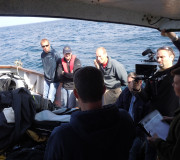
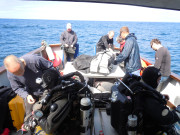
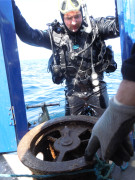
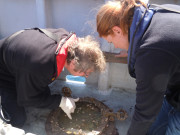

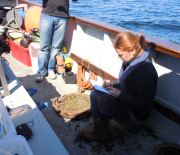


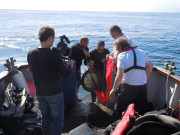
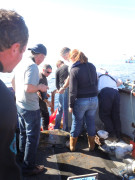
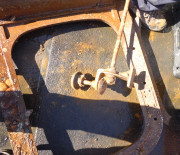
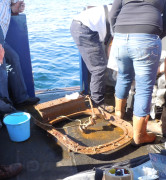


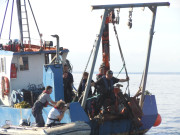
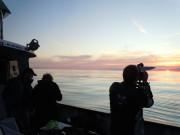
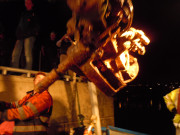
|
|
|
|